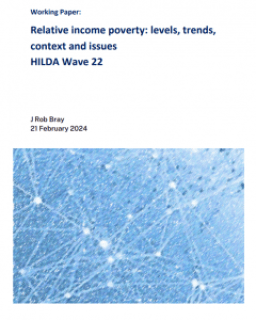
Abstract
There are many conceptions of what poverty means in contemporary western societies, and an array of ways of seeking to measure its incidence. Data from the Household, Income, and Labour Dynamics Australia (HILDA) survey is used here to consider these issues and analyse trends over the past 21 years to 2022, focusing on the most frequently used measure, relative income poverty, with the poverty line drawn at the 50 per cent of median income level. The rich set of other indicators of wellbeing and deprivation in the HILDA survey are also considered. Over the past two years there has been a marked increase in inequality in Australia, and an increase in measured poverty. More generally the analysis points to extensive disjunctures between measured relative income poverty and other measures of hardship, and the perceptions of people themselves. While there is a tendency for higher levels of adverse outcomes for those identified as being in poverty, generally those identified using relative income poverty measures do not report such occurrences
File attachments
| Attachment | Size |
|---|---|
| bray_hilda_w22_poverty.pdf(1.2 MB) | 1.2 MB |